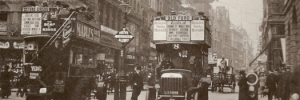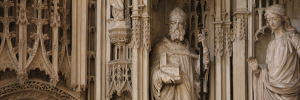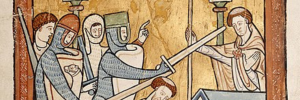The British Museum’s exhibition ‘Thomas Becket murder and the making of a saint’ closed on 22 August 2021. It is being held to mark the 850th year of his death (or the 900th of his birth), with the slight discrepancy of it now being 2021 (he lived 1120 to 1170) being explained by a postponement from last year due to lock-down.
The main drawback of exhibitions is usually the other people there, preventing you seeing what you want to see when you want to see it. There is good and bad news here. The exhibition as you might anticipate is dominated by small objects and documents displayed in their glass cases and you are at the mercy of the speed of other visitors in getting to see them. The good news is that there is still a reticence on the part of many to use public transport and numbers are well down on what might normally be expected, making for a relatively comfortable visitor experience (not such good news of the organisers obviously).
Becket was born in a house on Cheapside where the Mercers’s Hall stands today and the early part of his career was spent in London. He evidently took some pride in his origins in the capital. The exhibition includes the only surviving wax impression of his seal which, though it dates from when he was archbishop, describes it as ‘SIGILLUM TOME LUND’ (the seal of Thomas of London).
Becket after his death came to dominate the market in the veneration of saints in England, including in London. The chapel in the middle of London Bridge was, for example, dedicated to him. Saint Alban, England’s proto-martyr, and Saint Erkenwald, whose shrine was in St Pauls, among others, came to play secondary roles alongside the new Saint Thomas.
The exhibition includes a series of stained glass windows from Canterbury which show some of the miracles associated with him, and with his relics. The image is of a panel illustrating Ralph de Longville visiting Becket’s tomb and having his leprous leg washed with St Thomas’s Water, which he is also offered to drink.
Other treasures on show are various enamelled caskets to house his relics and manuscripts with illuminations illustrating his life and its background. These include the Eadwine Psalter with an intricate plan of the system of water pipes at Canterbury Cathedral, bringing in fresh water illustrated in green, and expelling the wastewater coloured red.
Ian McDiarmid is a qualified City of London Tour Guide who delivers guided walks and private tours in London. View all of Ian’s walking tours.
Listen to our London History podcast about Thomas Becket
Or watch below:



